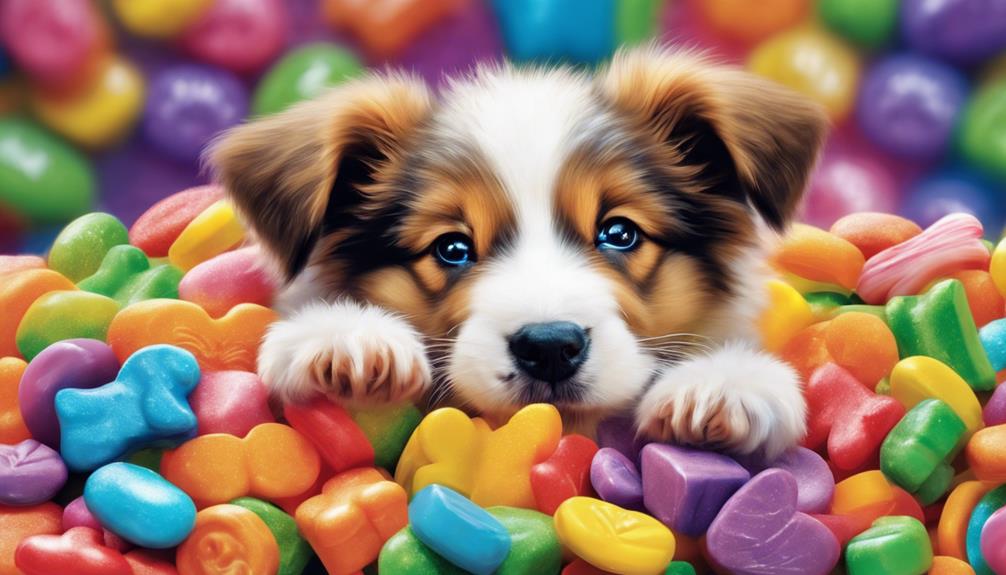Do you know that dogs have a peculiar habit of rolling in dead animals? This behavior may seem odd and off-putting to us, but for dogs, it serves a specific purpose. Understanding why dogs do this can help us better understand their instincts and motivations.
Dogs have been rolling in dead animals for centuries, and the reasons behind this behavior can be traced back to their ancestors, such as wolves. It turns out that there are several theories that explain why dogs exhibit this behavior.
Key Takeaways:
- Dogs roll in dead animals to scent mark and claim territory.
- Rolling in dead animals can be a form of communication between dogs.
- This behavior may be an instinctual remnant from dogs’ wolf ancestors.
- Sometimes, dogs simply enjoy the strong smell and find pleasure in rolling in dead animals.
- Preventing the behavior can be achieved through training, proper grooming, and managing the dog’s environment.
Scent Marking and Territory Claiming
One theory suggests that dogs roll in dead animals to deposit their natural scent on them, similar to scent marking their prey. This behavior is believed to be an instinctual way for dogs to claim the find as their own and keep other scavengers away. By wearing the scent of the dead animal, dogs may be signaling other dogs to stay away from their prize or to respect them for the kill or the find. It is a way for dogs to assert their dominance and protect their territory.
Understanding Scent Marking
Dogs have a keen sense of smell that allows them to identify and mark their territory. Scent marking is a natural behavior that helps dogs establish boundaries and communicate with other dogs. By rolling in dead animals, dogs leave their scent behind, effectively claiming the area as their own and warning other dogs to stay away. This behavior serves as a form of canine communication and reinforces their social status within the pack.
“Rolling in dead animals is a way for dogs to assert their dominance and protect their territory.”
The Role of Instinct
Rolling in dead animals can be traced back to the instinctual behaviors of dogs’ wolf ancestors. Wolves are known to roll in strong odors to mask their own scent while hunting. This behavior allows them to approach their prey without being detected. Dogs have inherited this instinct, which drives them to roll in foul-smelling substances such as dead animals. It is a survival mechanism deeply ingrained in their DNA.
A Form of Communication
Dogs are social animals that communicate with each other through scent. Rolling in dead animals can be a way for dogs to convey important information to other dogs in their vicinity. It can signal the presence of food, the discovery of a potential threat, or simply serve as a form of social bonding. By rolling in dead animals, dogs are communicating their experiences and discoveries to their canine counterparts.
Protecting Their Territory
Rolling in dead animals and depositing their scent helps dogs protect their territory from other animals. The strong odor left behind acts as a barrier, warning other dogs and potential intruders to stay away. It serves as a visual and olfactory signal, establishing the dog’s claim over the area. This behavior allows dogs to maintain control over their space and deter any threats or competition.
| Scent Marking Behavior | Significance |
|---|---|
| Rolling in dead animals | Claiming territory and asserting dominance |
| Depositing their natural scent | Communicating with other dogs |
| Protecting their territory | Warning other animals to stay away |
Communication and Signaling
Dogs are highly social animals that rely on various forms of communication to interact with other dogs. One interesting way they communicate is through scent. Rolling in dead animals can be a method for dogs to convey messages and signal to other dogs in their pack or neighborhood.
“Look what I found” or “There’s something tasty here.”
By rolling in dead animals, dogs are essentially saying, “Pay attention! I have discovered something interesting or delicious nearby.” This behavior serves as a form of communication within their pack, allowing them to share important information with other dogs.
Furthermore, rolling in dead animals can also be a way for dogs to establish their presence and assert their dominance. By leaving their scent on the carcass, dogs are signaling to other dogs that they have claimed the find as their own.
This form of communication through scent is deeply rooted in their ancestral behavior. Just like their wolf ancestors, dogs engage in this behavior to mark their territory and establish dominance.
It’s important to note that not all dogs engage in this behavior, and the motivations behind it may vary. Some dogs may roll in dead animals out of sheer enjoyment or as a result of their instinctual drive to explore and interact with their environment.
Understanding this aspect of dog behavior can help owners better comprehend their furry companions and provide appropriate training and management to prevent any unwanted rolling in dead animals.
The Importance of Scent in Canine Communication
Canine communication is a complex system that incorporates various senses, including sight, sound, and scent. While humans primarily rely on verbal and visual cues, dogs heavily rely on their olfactory sense to communicate with each other.
“Smell is the primary sense used by dogs to understand and perceive the world around them.”
Dogs possess an incredibly powerful sense of smell, with an estimated 300 million scent receptors compared to humans’ mere 5 million. This heightened olfactory ability allows them to detect and analyze a wide range of scents, including pheromones, hormones, and other chemical signals.
Through the intricate sense of smell, dogs can gather information about the environment, identify other dogs, and interpret emotions and intentions. Scent plays a crucial role in their social interactions, aiding in the recognition of familiar individuals, establishing social hierarchies, and conveying vital messages.
Rolling in dead animals, with their strong and distinct smell, serves as a powerful form of communication. It allows dogs to communicate their findings and share vital information with other dogs, facilitating social cohesion and cooperation within their canine community.
| Canine Communication Through Scent | Description |
|---|---|
| Territory Marking | Dogs mark their territory with scent to establish dominance and communicate boundaries. |
| Aggregation Pheromones | Dogs release pheromones in urine, feces, and saliva to communicate their location and attract other dogs. |
| Social Bonding | The exchange of scent during grooming and physical contact strengthens social bonds between dogs. |
| Mating and Reproduction | Scent plays a crucial role in attracting potential mates and signaling reproductive availability. |
| Arousal and Emotion | Dogs can detect the emotional state of other dogs through scent, influencing their own behavior. |
Understanding the significance of scent in canine communication sheds light on the intriguing behavior of dogs rolling in dead animals. It reflects their intricate social dynamics and highlights the importance of olfactory cues in their daily interactions.
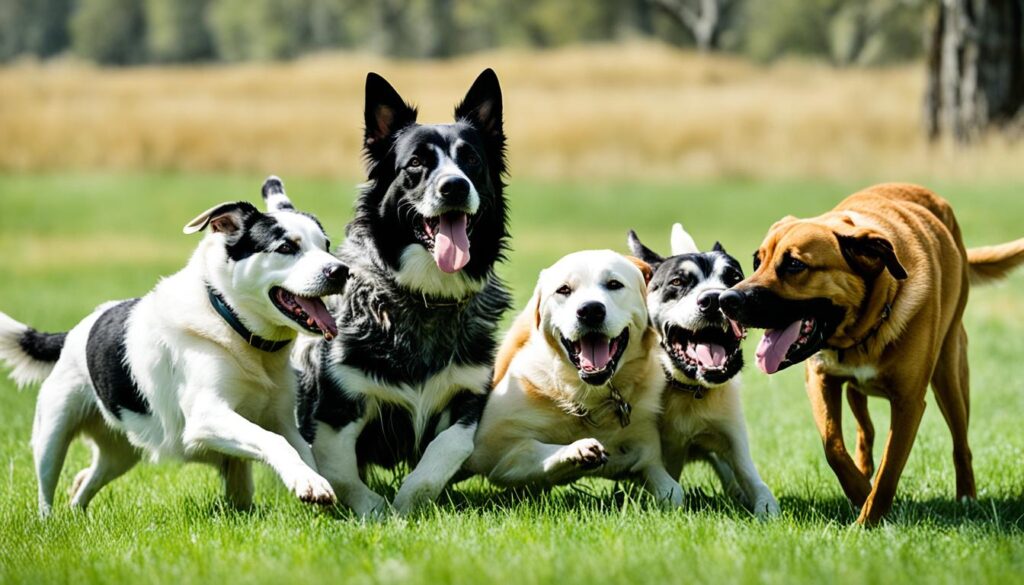
Instinctual Behavior from Wolf Ancestors
Dogs’ behavior of rolling in dead animals can be traced back to their wolf ancestors. Wolves are known to roll around in smelly stuff and dead things to mask their own odor on a hunt.

This behavior can be seen as an instinctual behavior that dogs have inherited from wolves. Rolling in dead animals helps dogs camouflage their natural scent, allowing them to hunt more successfully. It’s a way for dogs to tap into their primal instincts and embrace their wild ancestry.
Just as wolves use this behavior to hide their scent from prey, dogs may do the same to mask their presence and increase their chances of a successful hunt.
Although dogs are now domesticated, they still possess many behaviors and instincts from their wolf ancestors. Rolling in dead animals is just one example of the ways dogs display these innate behaviors.
The Link to Hunting
Rolling in dead animals is linked to hunting behavior. Dogs have a strong sense of smell, and masking their own scent with that of a dead animal can provide them with an advantage while pursuing prey. By rolling in the scent, dogs can mask their presence and potentially get closer to their target without being detected.
A Comparison of Wolf and Dog Behavior
| Behavior | Wolves | Dogs |
|---|---|---|
| Rolling in Dead Animals | Roll in dead animals to mask scent during hunting | Roll in dead animals to camouflage natural scent and potentially improve hunting success |
| Pack Hierarchy | Live in social hierarchies with alpha leaders | Have a tendency to establish a social hierarchy within a household |
| Territoriality | Mark and defend territories | Mark and defend territories, although to a lesser extent |
As seen in the table above, dogs and wolves share certain behavioral traits, including rolling in dead animals. This further emphasizes the link between dogs’ instinctual behavior and their wolf ancestry.
Captivating Their Instincts
Understanding that rolling in dead animals is an instinctual behavior can help dog owners make sense of it. It’s important to remember that dogs are still connected to their wild roots, and engaging in such behavior allows them to express their innate instincts. While it may seem unpleasant to humans, it serves a purpose for dogs and fulfills a part of their natural behavior.
By acknowledging and accepting dogs’ instinctual behavior, owners can better manage it and provide alternative outlets for their dogs to express themselves in a safe and appropriate manner.
Pleasure and Enjoyment
While the behavior of dogs rolling in dead animals may seem peculiar to humans, there is a theory that suggests that dogs actually enjoy it. Dogs have an exceptional sense of smell, and intense odors can be incredibly stimulating and pleasurable for them. What may be repugnant to humans can be attractive and exciting to dogs.
When a dog rolls in a dead animal, it can trigger a release of dopamine in their brain. Dopamine is a neurotransmitter that is associated with pleasure and reward. So, for dogs, rolling in foul smells can be a source of enjoyment and satisfaction.
It’s important to remember that dogs have different sensibilities and preferences compared to humans. While we may find the stench of decaying animals revolting, dogs find it fascinating and stimulating. Rolling in dead animals allows them to indulge in their natural instincts and experience a sensory adventure that brings them joy.
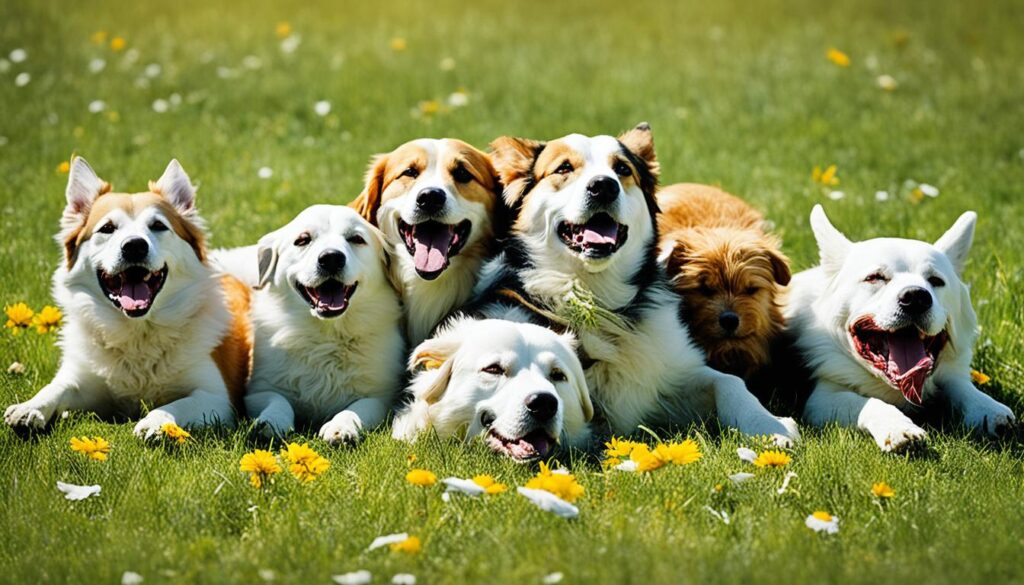
Preventing the Behavior
Preventing dogs from rolling in dead animals can be a challenge, but there are some strategies that dog owners can try.
Leash training and strong recall:
One effective method is to train your dog to walk on a leash and use a strong recall command. By keeping your dog on a leash, you have better control over their behavior and can prevent them from accessing dead animals. A solid recall command allows you to redirect your dog’s attention and discourage any attempts to roll in foul-smelling objects.
Fencing in the yard:
If you have a yard, consider installing a fence to keep your dog from encountering dead animals. This physical barrier can effectively restrict your dog’s access to areas where dead animals may be present, reducing the chances of them engaging in this behavior.
Providing mental and physical stimulation:
Boredom can contribute to dogs rolling in dead animals as a form of entertainment. To prevent this, make sure your dog receives plenty of mental and physical stimulation through regular exercise, interactive toys, and engaging training sessions. A tired and mentally stimulated dog is less likely to seek out unpleasant smells.
Regular grooming and bathing:
Grooming and bathing your dog on a regular basis can help remove the scent of dead animals from their fur. Use dog-safe shampoos and thoroughly wash their coat to eliminate any lingering odors. It’s important to follow proper grooming techniques to keep your dog’s skin and coat healthy while ensuring they are clean and free from the smell of dead animals.
To summarize, preventing dogs from rolling in dead animals involves a combination of training, environmental management, and proper grooming. By implementing these strategies, you can effectively manage your dog’s behavior and avoid the unpleasant smells associated with this instinctual behavior.
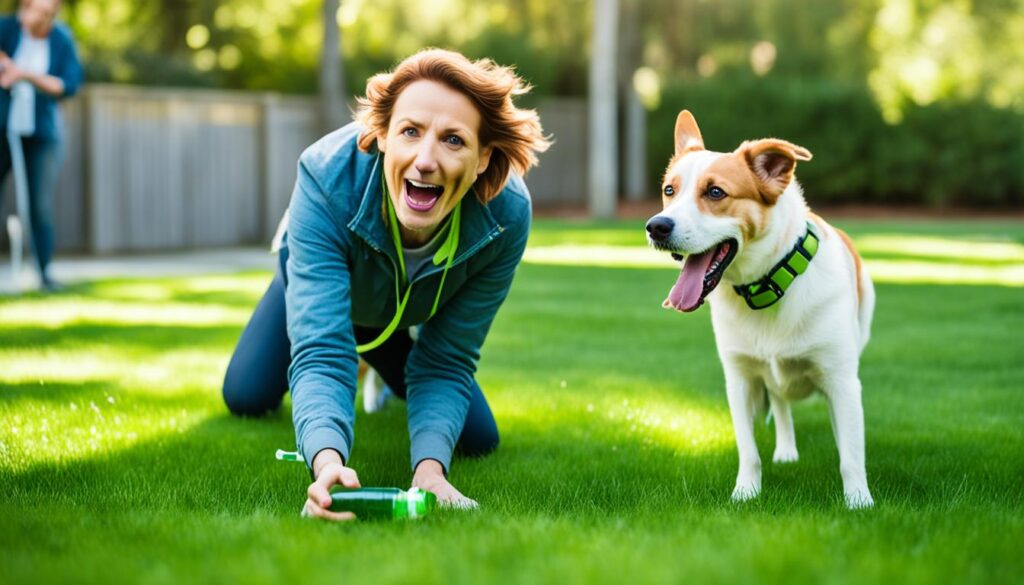
Bathing and Cleaning
If a dog has rolled in a dead animal, it’s important to bathe them right away. The foul smell can be quite strong and unpleasant, so bathing is necessary to remove the odor and keep your furry friend clean and fresh.
To start, use dog-safe shampoo and lather it into a rich foam. Gently massage the shampoo into your dog’s fur, making sure to cover all the areas that have come into contact with the dead animal. The shampoo will help break down the smelly substances and eliminate the odor.
Thoroughly rinse the shampoo off your dog, ensuring that no residue remains. It’s essential to rinse off all the shampoo to prevent skin irritation.
Image:
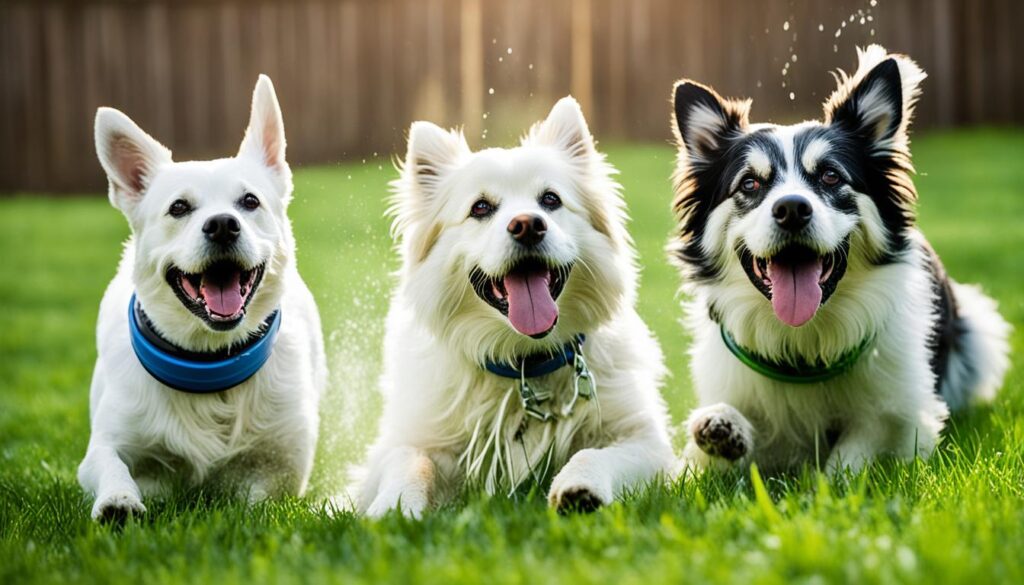
After bathing, you can use baking soda as a dry shampoo between baths to absorb any remaining odors. Sprinkle a small amount of baking soda onto your dog’s coat and gently rub it in. Let it sit for a few minutes, then brush it out. Baking soda is known for its odor-absorbing properties and can help neutralize any residual smells.
However, it’s important to note that excessive bathing should be avoided, as it can strip the dog’s natural oils and potentially cause skin issues. Aim for regular but not excessive bathing to maintain a healthy coat and skin.
Remember to take proper precautions to protect your dog’s skin and coat during the bathing process. Use lukewarm water and dog-specific products to prevent any irritation or allergic reactions.
Bathing your dog after they’ve rolled in a dead animal is an effective way to remove the foul smell and keep them fresh and clean.
Training and Recall
Training plays a crucial role in preventing dogs from rolling in dead animals. By teaching a strong recall command through positive reinforcement training, owners can redirect their dog’s attention and discourage the behavior.
Recall training is especially important in scenarios where a dog spots a dead animal and becomes fixated on it. By practicing recall commands in controlled environments and gradually introducing distractions, dogs can learn to respond to their owner’s call even when tempted by the presence of a dead animal.
Positive reinforcement training involves rewarding desired behaviors such as coming when called, sitting, or staying. By providing high-value treats and rewards, owners can create positive associations and reinforce good behavior. This approach helps dogs understand that obeying commands and staying away from dead animals leads to positive outcomes.
Consistency and patience are key in training dogs to prevent them from rolling in dead animals. Repetition and regular training sessions ensure that the dog becomes familiar with the desired behaviors and reinforces their training. It’s essential for owners to remain patient and understanding throughout the training process, as dogs may require time to adjust their behavior.
Key Points:
- Recall training helps redirect dogs’ attention and prevent them from engaging in the behavior of rolling in dead animals.
- Positive reinforcement training, using high-value treats and rewards, can reinforce good behavior and discourage dogs from rolling in foul smells.
- Consistency and patience in training are crucial for effectively managing and preventing this behavior.
Conclusion
Understanding dog behavior is crucial for managing and preventing the perplexing behavior of dogs rolling in dead animals. Whether it’s for scent marking, communication, instinctual behavior, or simply enjoyment, dogs have various motivations for engaging in this behavior.
By implementing training techniques, taking preventive measures, and prioritizing proper grooming, dog owners can ensure the well-being of their beloved pets while avoiding the unpleasant odors associated with rolling in dead animals. Leash training and recall commands can help control dogs’ behavior, preventing them from accessing dead animals. Providing mental and physical stimulation can reduce boredom and decrease the likelihood of this behavior. Regular grooming and bathing can remove the scent of dead animals from a dog’s fur, ensuring a fresh and pleasant-smelling pet.
Overall, by understanding the underlying reasons and implementing appropriate measures, dog owners can successfully manage and prevent dogs from rolling in dead animals, creating a happier and more odor-free environment for both dogs and their owners.



